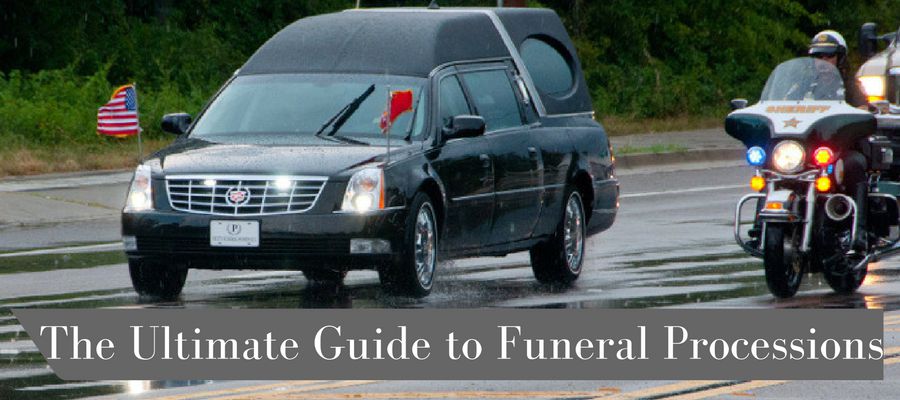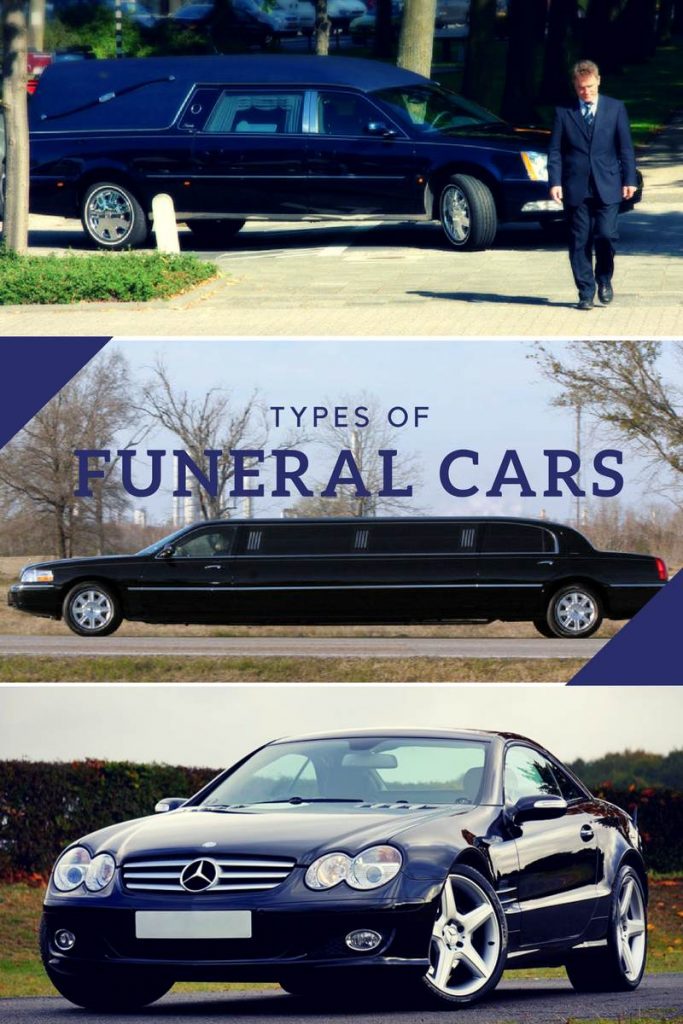
You have likely seen a funeral procession before whether it be on TV, as a pedestrian or you might have even driven in one yourself. A funeral procession is a parade of vehicles transporting adeceased person from a memorial site to their final resting place.
If you have ever attended a funeral service, you are probably familiar with a funeral procession. Typically, when guests arrive to a funeral service, the funeral home or church (or wherever the service takes place) has funeral attendants (staff members of the funeral home) waiting to instruct you where to park your vehicle.
Those vehicles that will be traveling in the procession tend to be parked in rows, with cars being bumper to bumper. If you will not be driving to the burial site in the funeral procession, the funeral attendants might direct you to park in another area.
What you might be less familiar with are the funeral procession laws and funeral procession etiquette that dictate what exactly you are supposed to do when you are driving in a funeral procession or when you encounter one as a driver.
Fear not, we have you covered. This article will break down everything you need to know about funeral processions including the history and significance of this tradition, the rules of the road for traveling in a funeral processions and basic etiquette when observing a procession.

The History of Funeral Processions
In ancient times, the Roman funeral was considered a rite of passage that signified the transition from life to death.
It was very important in Roman tradition that these ceremonies and burials be conducted properly to avoid evil spirits rising from the underworld.
An important aspect of this ancient funeral tradition was the procession. It was marked by the movement of bodies, both those living as well as the dead, and the noise that the procession generated.
The grander the funeral procession was an indication of the wealth or fame of the deceased person.
These processions would often include musicians and professional mourners were paid to participate.
A large number of professional mourners were a symbol of the deceased’s person’s wealth and power.
Clients of the deceased also participated in the procession as a sign of respect to their fallen patron.
Actors wearing masks that attempted to reproduce the deceased’s ancestors and personas formed the next part of the procession.
Ancestor worship was fundamental to Roman’s beliefs about death and the afterlife.
Next in the procession following these actors, was the corpse carried on a bed-like tray, followed lastly by the family members of the deceased.
However, funeral processions have evolved over the years. They started out as people simply walking and carrying the deceased into a place of worship, or from their home to the burial site.
Nowadays, more modern vehicle processions with hearses and limousines being used to transport the deceased and family members, and a ceremonial procession to begin the funeral service.

Funeral Procession Definition
So what exactly is a funeral procession? A funeral procession is a term that is often used to describe two things: a motorcade to the funeral service or place of burial, or the order followed to lead the deceased’s body into a church for the funeral service.
Therefore, the term ‘funeral procession’ can either refer to a procession that is lead by motor vehicle or on foot from a funeral home or church (or whatever memorial site is used), to the cemetery where the deceased will be interred or the part of the funeral service where a procession leads the deceased’s body into the church (or memorial site) for the service.
In the procession that leads the deceased’s body into the memorial site for the service, the minister or priest officiating the funeral service typically leads this type of procession, followed by altar boys (in a Catholic mass) or other people serving (i.e. the choir), who are then followed by the pallbearers, two by two, in front of the casket.
The pallbearers are followed by the family of the deceased.
In a funeral procession transporting the deceased’s body from the service to the burial site, a hearse is typically used to transport the body followed by family members in other vehicles forming the procession.
Funeral processions are a long-standing tradition for funeral services.

Types of Funeral Cars in a Procession
 Funeral Homes offer various types of funeral cars to transport the deceased and their family from the funeral service to the burial site. Theseoptions include: a hearse or ‘funeral coach’, limousines, and other funeral service vehicles.
Funeral Homes offer various types of funeral cars to transport the deceased and their family from the funeral service to the burial site. Theseoptions include: a hearse or ‘funeral coach’, limousines, and other funeral service vehicles.
Funeral Coach or Hearse Definition
A hearse is a type of funeral car that is used to transport the deceased from the memorial site (the funeral home or church) to the burial site (cemetery).
Limousine Definition
Limousines are large, luxurious cars that are usually driven by a chauffer who is separated from the passengers by a partition for privacy. Limousines are typically used to transport the immediate family of the deceased person in a funeral procession.
Funeral Service Vehicles Definition
These funeral cars might include black sedans that are less expensive options of transport than a hearse or a limousine. These vehicles also include various service cars.

What is the Purpose of a Funeral Procession?
Unlike the past where the funeral procession was an important part of the funeral tradition to prevent evil spirits from rising from the underworld, today, funeral processions are purely ceremonial.
The main purpose of a funeral procession now is to allow those who are attending the funeral to travel together to the place of worship, and from the place of worship or memorial to the cemetery.
This provides mourners with the opportunity to grieve together on their way to and from the funeral and to lean on each other for emotional support.
In addition, the actual vehicle procession from the place of worship, or wherever the service is being held, to the burial site is a way to include the community in acknowledging that someone in the community has died.
Funeral processions typically travel at slow speed, all cars in the procession have their lights on and traffic will pull over and allow the procession to pass.
Unfortunately nowadays, this sense of community involvement and sign of respect paid to the deceased can be met with impatience and road rage from drivers who are travelling through the path of the procession.
For this reason, most modern funeral processions now tend to follow the speed limit to reduce driver frustration.

Funeral Procession Etiquette: 7 Key Tips for Driving in a Procession
- 1) If you are a close friend or family member of the deceased but will be driving your own car in the funeral procession, you should try to arrive at the funeral service 45 minutes early to ensure that you will be parked near the front of the procession line. Cars are typically parked in the order that they arrive.
- 2) Immediately after the funeral service, the pallbearers will carry the casket outside the funeral home or church and place it in the hearse for transport to the burial site. Wait for a funeral attendant to direct you to get in your vehicle and be ready to follow those ahead of you in the procession line.
- 3) The procession is typically led by a ‘lead car’ (usually a black sedan or other large funeral car) and usually bears white funeral flags and has their hazard lights flashing. This is a signal to other motorists that a funeral procession is moving through traffic. The ‘lead car’ is then followed by the hearse, and then the immediate family of the deceased (usually in limousines), and then all the other vehicles driving in the procession. Always keep an eye out for the ‘lead car’ to ensure that you are going the right way.
- 4) Stay close to the car directly in front of you at all times throughout the procession. You do not want to leave enough room for someone who is not driving in the procession to cut in from regular traffic.
- 5) You might also be asked to turn your headlights on while driving to the cemetery in the procession. This signifies to other motorists that you are part of a funeral procession.
- 6) Stay in line with the procession. Do not leave the procession line except in the case of an emergency.
- 7) Once you have arrived at the cemetery, there will likely be an attendant from the cemetery there to lead motorists from the procession to the burial site. Wait in your vehicle for instruction from the attendant.
Funeral Processions Laws: 3 Major Rules of the Road
- 1) Be prepared to drive very slowly. Funeral processions usually go no faster than 50-65 kph (30-40 mph) on normal roads, depending on the listed speed limit, and no more than 80 kph (55 mph) on highways.
- 2) In the United States motorists in a funeral procession have a legally-binding right-of-way. In Canada, for the most part, the rules of the road prevail.
- 3) Stay with the funeral procession at all times. In the US, this is the case even if this means you are going through a red light at an intersection because there are funeral procession laws giving processions a legally-binding right-of-way. In Canada, there are no funeral procession laws. However, proper etiquette would dictate that traffic would pull over, to let the procession go by together.
Funeral Procession Etiquette: What to Do When You Encounter a Procession
- 1) Be respectful of the funeral procession. DO NOT honk at the procession.
- 2) Yield to the entire procession without interruption. As soon as you see the lead car of the funeral procession, you should let the entire procession pass through, even if the traffic signal dictates that it is your turn to pass through the intersection. Stop and wait until all cars in the funeral procession have passed. DO NOT try to cut through the procession.
- 3) Look for the last vehicle in the procession. Usually, the very last car in the funeral procession will have 2 funeral flags and will also have their hazard lights flashing to let other motorists that the procession has ended. This is a signal that regular traffic may resume. DO NOT attempt to pass an entire funeral procession on the right side of the road (unless the procession is in the left lane).
Remember…
Although respect for funeral processions on the part of motorists is waning, the funeral procession is still a fundamental tradition of modern funerals and allows mourners grieving a loss to travel together from the funeral service to the burial site.
It is a ceremonial way to show respect for the deceased and their family.
Although you are not legally obligated to, when it is safe to do so, it is both courteous and respectful to allow for mourners travelling in a funeral procession to proceed uninterrupted, even though the rules of the road do still prevail.
This tradition has been around for hundreds of years and still holds significance to individuals mourning a loss.
How do you show respect to the deceased during a funeral procession?


